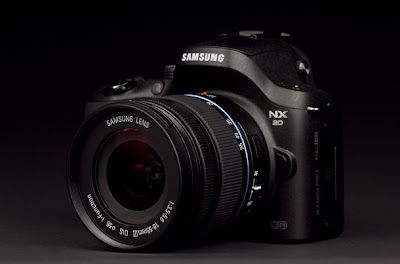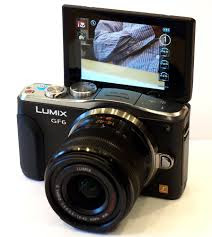Samsung NX20 Review
Highs: Top notch stills and quality videos
Excellent iFunction lens with OIS
Superior vari-angle screen
Lows: Forget high-speed burst mode
Occasional focusing issues
Noisy at high ISOs
Features and Design
The 20.3-megapixel NX20 not only looks like a small DSLR, it has all the features you’ll find on their bigger cousins such as a built-in viewfinder, mode dial, and pop-up flash. Many CSCs lack these critical features and we give Samsung a pat on the back for the convenience. The camera really is small, measuring 4.8 x 3.5 x 1.5, tipping the scales at 12 ounces without a lens. Even with the supplied 18-55 OIS glass, we had no problems carrying the NX20 anywhere and everywhere.
As with any interchangeable lens camera, the most important feature on the front is the lens mount. Here it’s Samsung’s NX mount and there are 11 lenses available, covering most of the photographic bases.
On the top deck are the built-in flash, hot shoe, stereo mics, mode dial, jog wheel, as well as metering and green buttons. This last one resets values you might’ve changed in the menus. The combo shutter and on/off switch are angled on the fairly substantial grip. The mode dial has everything you’d expect including Smart (auto), PASM, and Custom. There’s also Wi-Fi for sharing, Movie, Scene, and iEffect (filters).
On the back is a killer 3-inch AMOLED vari-angle display (rated 614K dots). It’s really high-contrast with deep blacks. There were very few times it wiped out, even in direct sunlight. We used the electronic viewfinder (EVF) more for convenience when holding the camera up to our eyes rather than out of necessity. It’s SVGA (800×600), very clear with 100-percent coverage and there’s a diopter adjustment to individually fine-tune it.
Also on the back is a nice thumb rest, a red-dot video button, and many of same buttons/controls you’ll find on a DSLR – exposure compensation, AEL (auto exposure lock), Function, and so on. It’s a bit busy but hardly intimidating. You can use it in aim-and-forget auto mode or tweak it to your heart’s content. ISO options range from 100-12,800, and shutter speeds are 1/8000-30 seconds. You can shoot in RAW at 8 frames per second for 11 shots (at continuous high mode). Toss in a very nicely designed menu system and the NX20 will take you where you want to go – to a point, as we’ll see shortly.
What’s in the Box
You’ll find the camera and the 18-55mm OIS iFunction lens, various caps/covers, battery, and charger plus USB cable and strap. You also get a basic printed manual along with the full version on the included CD-ROM. Samsung also supplies Intelli-studio and Samsung RAW converter software on the disk for handling images.
Performance and Use
The NX20 uses Contrast AF focusing, not the phase detect of DSLRs. While it works okay for the most part, there are times the camera has difficulty grabbing focus. This is something that occurs with almost every CSC we’ve used. It’s not a deal breaker as this type of interchangeable lens camera is a lot smaller than any DSLR and Live View is much more fluid than any DSLR’s. In other words, no camera is perfect as there are always tradeoffs of one kind or another.
We had the camera with us in Florida, the Northeast, with some palm trees in Aruba thrown in for good measure. We did most of our shooting in Smart (auto) mode then proceeded through the mode dial as subjects warranted; resolution was maxed out for stills and videos (5472 x 3648 pixels, 1920 x 1080/30p MP4).
Using the NX20 is very pleasant. It has a good feel, controls are easy to find and use, plus the menu system is clean and user friendly. You should first peruse the manual to dig into the camera’s capabilities but you’ll hardly refer to it once you start shooting.
We’re big fans of Samsung’s iFunction lens system. Once you move out of Smart (auto) by pressing the iFunction button on the side of the lens you can change settings just by turning the lens ring or jog wheel on the top deck. There are options for shutter speed, ISO, exposure value (EV), white balance (WB), and digital zoom, depending on your needs. It’s simple and fun to use with a really attractive interface. Anything that makes it easier for people to make the most out of their cameras is heartily welcomed.
Before getting into the photographic results, let’s discuss a really strange experience we had. A refresher, this is a 20.3-megapixel CSC that uses an APS-C size sensor capable of ripping off a burst of full-res JPEGs at 8 fps for 11 frames. This is an excellent spec. However, when you use this setting for a full burst, the camera basically freezes as it tries to save all the large files to memory. On several occasions, the “ready” lamp continued to flash during this process and wouldn’t stop. In order to continue our tests, we had to take the battery out, reinsert it, and reboot. Of the cameras we have tested, this was one of the few times we had to use this trick. Clearly the company has to beef up the processing – or else we had a lemon. However, judging by the results we saw onscreen and the zero problems using single-shot and low-burst modes (3 fps), this wasn’t the case.
Now with this nasty issue is out of the way, let’s discuss the photographs and videos. On a 27-inch display the stills looked outstanding, even at 100-percent enlargements. Colors were rich, deep, and accurate – exactly what you want with any camera. In fact, we can easily state the Samsung NX20 delivered dynamite images in bright Florida and Aruba sunshine as well as less well-lit indoor subjects (see samples). As is the case with any camera, there was more digital noise shooting in low light but you’re fine up to ISO 800 – even 1,250 – but things get messy as you move higher. We found the lens delivered very sharp, finely-focused images with hardly any blur; Samsung’s OIS (optical image stabilization) did its job.
Videos were also quite good. We generally like CSCs for movies versus DSLRs (other than Sony Translucent Mirror models). Focusing is much simpler and there’s no need to deal with flipping the mirror up in Live View. We were in Florida for a wedding and the NX20 handled the flashing lights and twisting bodies as the band played. We’re hardly Hollywood cinematographers but the results were solid with little of the “rolling shutter” waves of many DSLRs. Sound was surprisingly good too.
As noted, the NX20 has built-in Wi-Fi. It’s hardly the simple sharing of a smartphone but it’s relatively painless. Just download the Samsung MobileLink app to your smartphone (iOS/Android) and you can upload JPEGs to the Web or your phone; there’s no native app for the iPad in the App Store, but you can use the iPhone version.
Conclusion
Overall, the Samsung NX20 is an excellent camera. Still quality is superb and movies are very good. It’s a good choice for both aim-and-forgetters and those who tweak every image to the nth degrees. However, avoid the high-speed burst mode or you may have to do a reboot. So forget the speeding bullets, stick to more leisurely action and you’ll be in fine shape.
Source: www.digitaltrends.com/digital-camera-reviews/samsung-nx20-review/













